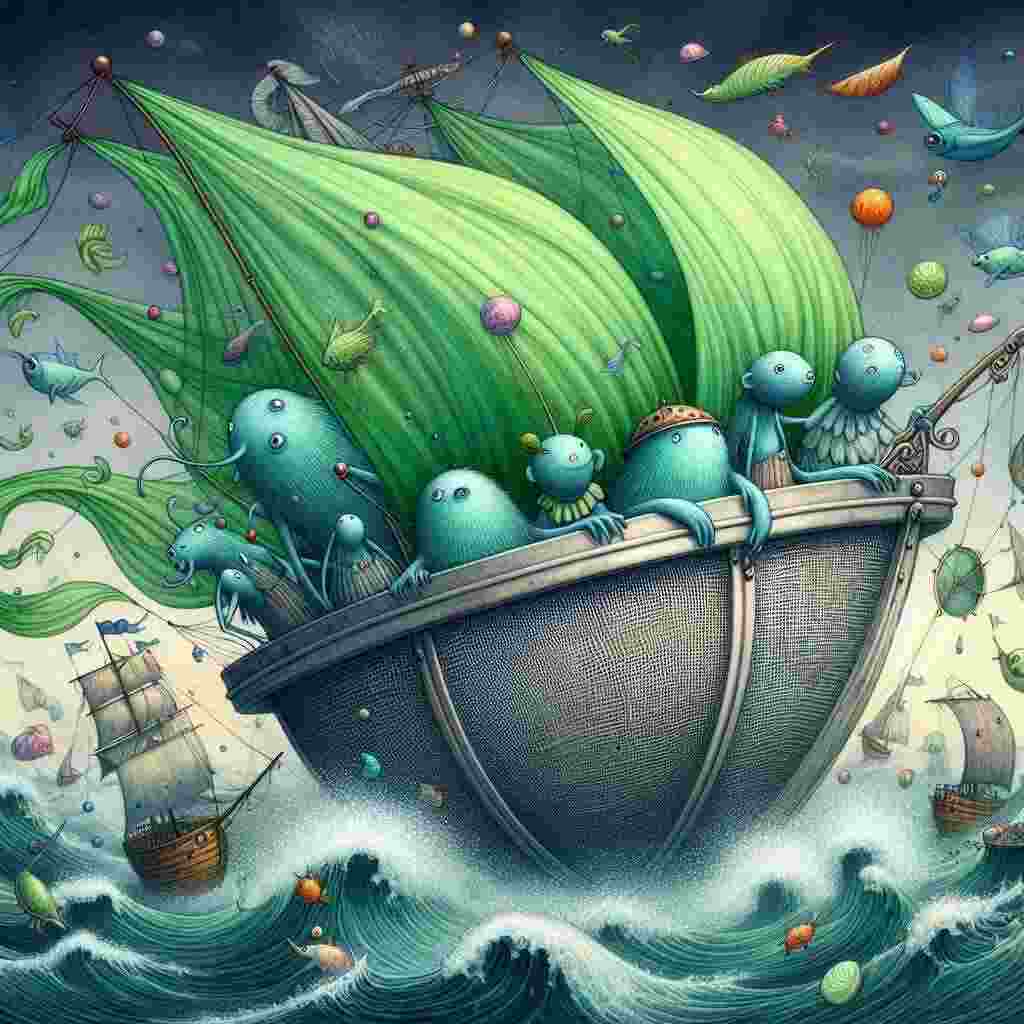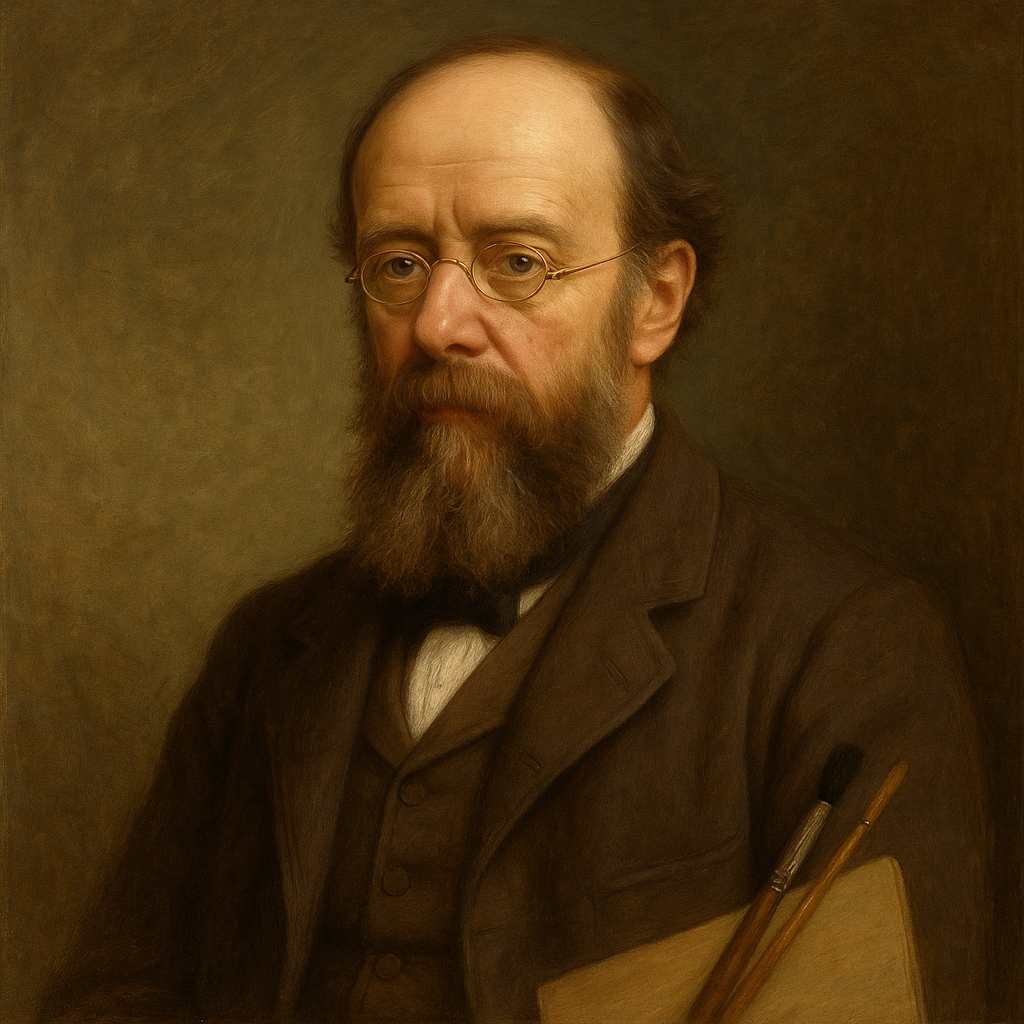The Jumblies
Edward Lear
1812 to 1888

I
They went to sea in a Sieve, they did,
In a Sieve they went to sea:
In spite of all their friends could say,
On a winter’s morn, on a stormy day,
In a Sieve they went to sea!
And when the Sieve turned round and round,
And every one cried, ‘You’ll all be drowned!’
They called aloud, ‘Our Sieve ain’t big,
But we don’t care a button! we don’t care a fig!
In a Sieve we’ll go to sea!’
Far and few, far and few,
Are the lands where the Jumblies live;
Their heads are green, and their hands are blue,
And they went to sea in a Sieve.
II
They sailed away in a Sieve, they did,
In a Sieve they sailed so fast,
With only a beautiful pea-green veil
Tied with a riband by way of a sail,
To a small tobacco-pipe mast;
And every one said, who saw them go,
‘O won’t they be soon upset, you know!
For the sky is dark, and the voyage is long,
And happen what may, it’s extremely wrong
In a Sieve to sail so fast!’
Far and few, far and few,
Are the lands where the Jumblies live;
Their heads are green, and their hands are blue,
And they went to sea in a Sieve.
III
The water it soon came in, it did,
The water it soon came in;
So to keep them dry, they wrapped their feet
In a pinky paper all folded neat,
And they fastened it down with a pin.
And they passed the night in a crockery-jar,
And each of them said, ‘How wise we are!
Though the sky be dark, and the voyage be long,
Yet we never can think we were rash or wrong,
While round in our Sieve we spin!’
Far and few, far and few,
Are the lands where the Jumblies live;
Their heads are green, and their hands are blue,
And they went to sea in a Sieve.
IV
And all night long they sailed away;
And when the sun went down,
They whistled and warbled a moony song
To the echoing sound of a coppery gong,
In the shade of the mountains brown.
‘O Timballo! How happy we are,
When we live in a sieve and a crockery-jar,
And all night long in the moonlight pale,
We sail away with a pea-green sail,
In the shade of the mountains brown!’
Far and few, far and few,
Are the lands where the Jumblies live;
Their heads are green, and their hands are blue,
And they went to sea in a Sieve.
V
They sailed to the Western Sea, they did,
To a land all covered with trees,
And they bought an Owl, and a useful Cart,
And a pound of Rice, and a Cranberry Tart,
And a hive of silvery Bees.
And they bought a Pig, and some green Jack-daws,
And a lovely Monkey with lollipop paws,
And forty bottles of Ring-Bo-Ree,
And no end of Stilton Cheese.
Far and few, far and few,
Are the lands where the Jumblies live;
Their heads are green, and their hands are blue,
And they went to sea in a Sieve.
VI
And in twenty years they all came back,
In twenty years or more,
And every one said, ‘How tall they’ve grown!’
For they’ve been to the Lakes, and the Torrible Zone,
And the hills of the Chankly Bore;
And they drank their health, and gave them a feast
Of dumplings made of beautiful yeast;
And everyone said, ‘If we only live,
We too will go to sea in a Sieve,—
To the hills of the Chankly Bore!’
Far and few, far and few,
Are the lands where the Jumblies live;
Their heads are green, and their hands are blue,
And they went to sea in a Sieve.
Edward Lear's The Jumblies
Edward Lear's poem "The Jumblies" is a whimsical and nonsensical narrative that exemplifies the characteristics of his literary nonsense genre. Through its playful language, imaginative imagery, and absurd plot, the poem explores themes of adventure, nonconformity, and the triumph of the seemingly impossible. This analysis will delve into the poem's structure, literary devices, and underlying messages to uncover its deeper meanings and significance.
The poem is structured in six stanzas, each followed by a recurring refrain. This repetitive structure creates a musical quality that enhances the poem's childlike tone and reinforces its central motif. The consistent rhyme scheme and meter contribute to the poem's sing-song quality, making it both memorable and enjoyable to recite. This musical aspect of the poem aligns with Lear's background as a composer and illustrator, demonstrating his ability to create a multisensory experience through words alone.
At the heart of "The Jumblies" is the absurd premise of a group of peculiar creatures embarking on a sea voyage in a sieve. This central image serves as a metaphor for pursuing seemingly impossible dreams and defying conventional wisdom. The Jumblies' decision to use a sieve as a boat is met with skepticism and warnings from others, yet they persist in their adventure. This can be interpreted as a commentary on societal pressures and the importance of maintaining one's individuality and sense of wonder in the face of criticism.
Lear employs vivid and often nonsensical imagery throughout the poem to create a fantastical world. The Jumblies themselves are described with "green heads" and "blue hands," immediately establishing them as otherworldly beings. The imagery becomes increasingly absurd as the poem progresses, with the Jumblies using a "pea-green veil" as a sail and spending the night in a "crockery-jar." These surreal elements contribute to the poem's dreamlike quality and invite readers to embrace the illogical and imaginative.
The journey of the Jumblies can be seen as an allegory for personal growth and the rewards of taking risks. Despite the initial warnings and seemingly precarious nature of their voyage, the Jumblies not only survive but thrive. They return after twenty years, having grown tall and experienced exotic locations like "the Lakes, and the Torrible Zone, and the hills of the Chankly Bore." This transformation suggests that embracing the unknown and challenging oneself can lead to profound personal development.
Lear's use of made-up words and places, such as "Ring-Bo-Ree" and "Chankly Bore," is a hallmark of literary nonsense. These inventive terms create a sense of the exotic and unknown, while also allowing readers to project their own meanings onto the text. This linguistic playfulness encourages creativity and imagination in the reader, mirroring the adventurous spirit of the Jumblies themselves.
The recurring refrain, "Far and few, far and few, / Are the lands where the Jumblies live," serves multiple purposes within the poem. It creates a sense of mystery around the Jumblies' origins and emphasizes their uniqueness. Additionally, it acts as a rhythmic break between stanzas, allowing readers to pause and reflect on the events described. The refrain's unchanging nature amid the Jumblies' evolving journey also provides a sense of constancy and identity throughout their transformative adventure.
The poem's conclusion presents a shift in perspective from the community that initially doubted the Jumblies. Upon their return, the Jumblies are celebrated, and others express a desire to embark on similar journeys. This change in attitude reflects the power of success to alter perceptions and inspire others. It also suggests that societal norms can be challenged and changed through individual acts of courage and imagination.
In a broader context, "The Jumblies" can be read as a celebration of the outsider and the nonconformist. The Jumblies' green heads and blue hands mark them as different from the start, yet it is precisely their uniqueness that enables their extraordinary journey. This embrace of the unusual and the outcast is a recurring theme in Lear's work and resonates with readers who feel at odds with societal expectations.
While often categorized as children's literature, "The Jumblies" offers layers of meaning that appeal to readers of all ages. Its surface-level silliness belies a deeper exploration of human nature, societal pressures, and the value of maintaining a sense of wonder and adventure throughout life. Lear's masterful blend of the absurd and the profound continues to captivate readers, ensuring the poem's enduring place in the canon of English literature.
In conclusion, "The Jumblies" stands as a testament to Edward Lear's genius in the realm of literary nonsense. Through its inventive language, memorable imagery, and underlying themes of adventure and nonconformity, the poem encourages readers to question conventional wisdom and embrace the extraordinary. It reminds us that sometimes the most unlikely vessels - be they sieves or unconventional ideas - can lead to the most remarkable journeys.
This text was generated by AI and is for reference only. Learn more
Want to join the discussion? Reopen or create a unique username to comment. No personal details required!



Comments
No comments yet. Be the first to comment!